on the GR Corolla, Clouds, Oil, Autonomy & the VW Taos
Things you probably didn’t catch about the GR Corolla, how clouds are getting big investments, what the VW Taos is like, where U.S. oil imports come from, how Aurora is developing its AV systems for commercial trucks and passenger vehicles, and a focus on the middle class. . .in China.
Some Other Points About the GR Corolla
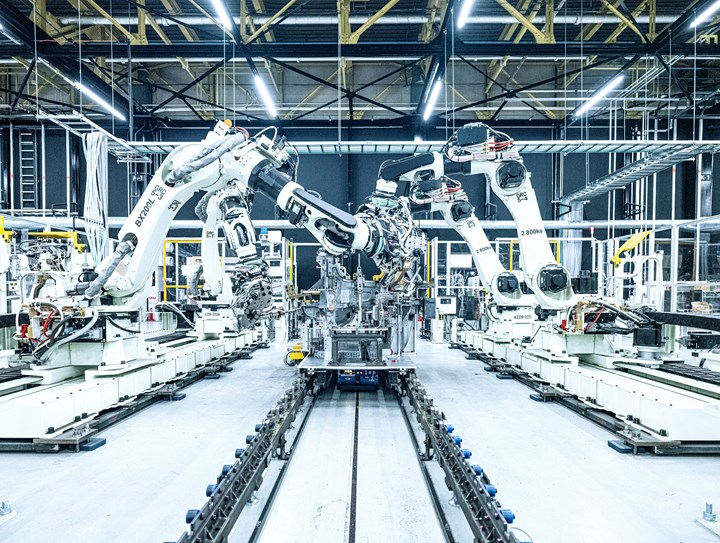
Inside the Toyota Motomachi Plant were the GR Corolla is built. (Image: Toyota)
By now you’ve probably read about the 2023 GR Corolla, the 300-hp, 273-lb. ft. of torque hot hatch that Toyota is rolling out for those who like to slam through the gears of a six-speed manual as they drive in ways that would cause driver’s education teachers’ hair to turn gray just by watching.
But here are some (somewhat) engineering-related things that you may not have seen in the coverage tinged with testosterone:
- There are two versions: Core Grade and Circuit Edition. Core Grade has an aluminum roof. Circuit Edition has a forged carbon sheet molded compound roof (i.e., it is not woven carbon fiber).
- All GR Corollas have an aluminum hood and front doors.
- High-tensile steel is used in structural applications for light-weight safety.
- Both welding and structural adhesives are used for assembly. An objective is to increase overall vehicle rigidity.
- A GR-specific production area has been established in the Toyota Motomachi Plant. Both the GR Corolla and GR Yaris (not available in the U.S. but similarly hot) are built there. (The two vehicles share the same three-cylinder engine, although the output of the version in the Corolla is boosted, in part though the use of a three-piece muffler that improves exhaust efficiency.)
- The layout of the production is based on automated guided vehicles (AGVs) rather than conveyors. The work areas are based on cells. There are more manual operations performed than is the norm (although as that photo above indicates, there are robots). Many of the manual operations are performed by skilled technicians who were brought to the operation by Toyota Gazoo Racing (which, incidentally, is what the “GR” stands for).
///
Cloud$
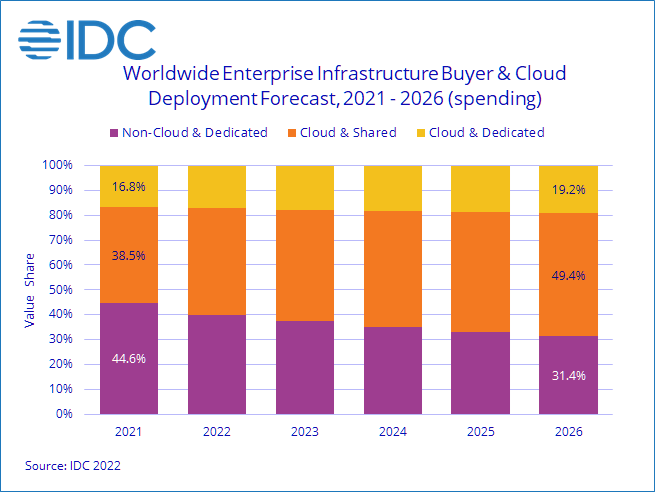
Spending on cloud capability is clearly quite solid. (Image: IDC)
Although when people talk about sending something to or storing something in “the cloud,” there is almost an ethereal sense to it, as though it is a realm of digital gossamer.
But it is quite real. And non-trivial vis-à-vis investments.
International Data Corporation (IDC) has released numbers for the amount of 2021worldwide investment in cloud infrastructure:
$73.9 billion.
That is an increase of 8.8% over 2020.
The area with the biggest increase in investment?
Asia/Pacific (excluding Japan and China), or APeJC in IDC acronym.
The year-over-year increase was 43.7%.
The U.S. had a YoY increase of 1.5%.
Here’s something that is anything but ethereal:
IDC expects that the spend on compute and storage cloud infrastructure will have a compound annual growth rate of 12.6% between 2021 and 2026, reaching $133.7 billion in ‘26.
That is serious spending.
///
2022 VW Taos SEL
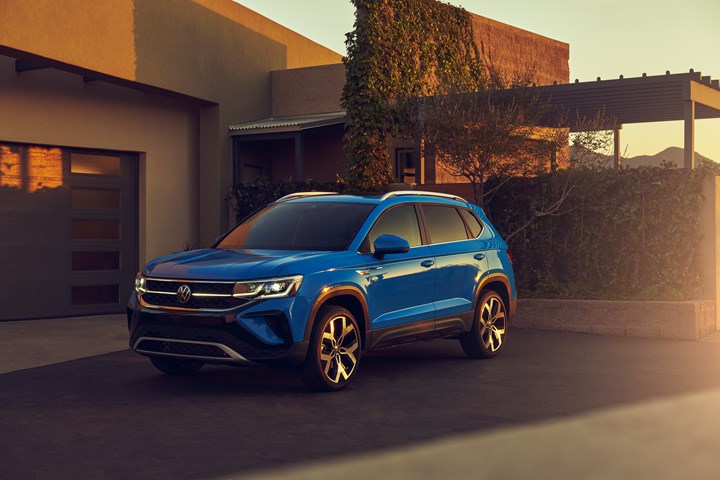
The VW Taos. Although it is the entry SUV for the brand, it shares resemblance with its bigger brethren. (Image: Volkswagen)
The Volkswagen Taos is an entry-compact SUV with a whole lot of traction in the market. It is remarkable that the Taos, which was launched mid-2021, ended the year with sales of 31,682 units.
Say that it had a full year. Say that the sales pace was the same. That would have 63,364 for 12 months. Which would have put it ahead of other VW vehicles in the showroom (assuming those months were all in 2021), such as the Jetta (61,967) and the Atlas Cross Sport (43,303).
That’s traction.
==
In the VW lineup of SUVs, Taos is where things start. The ladder then goes to the Tiguan and then the Atlas. (Although the ID.4 is considered to be an SUV, it is first and foremost an electric vehicle, so at this comparatively early stage of EV availability, I’d argue that consumers would approach it as an EV first and then, somewhere along the lines in their cogitation regarding what they might buy, it would occur to them that it is an SUV.)
==
Speaking of other models, here’s something interesting.
The Taos is based on the VW MQB platform.
The interesting part? So is the Atlas, and that name connotes the size of the vehicle.
Yet the dimensions of the Taos are 175.8 inches long, 72.5 inches wide, 64.4 inches tall.
Meanwhile, the Atlas is 200.7 inches long, 78.3 inches wide, 70.1 inches tall.
That is flexibility.
==
The Taos comes in three trim levels—S, SE and SEL—and with either front drive or all-wheel drive (known in VW World as “4Motion”).
The entry (S with front drive) has an MSRP of $22,995.
The top-of-the-line SEL with 4Motion is $33,045.
The vehicle I drove was the SEL 4Motion that had an optional paint ($395) and a $1,200 panoramic sunroof (with the panorama being for both rows).
Which means the vehicle came in at $35,835.
==
The Taos is powered by a 1.5-liter turbocharged engine across the board. It produces 158 hp and 184 lb-ft of torque.
The versions with the 4Motion setup come with 7-speed dual-clutch automatic. (The other available transmission is an 8-speed automatic.)
While there aren’t a whole lot of 1.5-liter engines out there*, the EA211 TSI is calibrated to give a quick response when accelerating.
And the fuel economy numbers for the vehicle with the 4Motion are 25 city, 32 highway, 28 combined, which is certainly a good thing as fuel prices are now (4/5/22) averaging $4.17, according to the U.S. Energy Information Administration.
The 4Motion provides an “Active Control” dial that allows the selection of Onroad, Snow, Offroad, and Custom Offroad settings. Various adjustments are made, such as transmission, steering and traction settings.
I think the Custom Offroad is a bit optimistic: the ground clearance of a Taos is 6.4 inches. The ground clearance of a Jetta is 5.5 inches. . . .
And while on the subject of the ride, the 4Motion vehicle, like the FWD version, has a strut-type front suspension, but unlike the FWD version, a multilink setup in the rear (FWD gets a torsion beam).
Often when driving big vehicles it is a good thing if the vehicle “drives small” (i.e., doesn’t seem like piloting a barge). In the Taos, it “drives big(ger),” a good thing in that when you are in an environment like Detroit, where full-size pickups roam, the Taos doesn’t feel like flotsam-in-becoming.
==
Inside the vehicle, the materials, in general, seem better than what one might anticipate in an entry-level SUV—although in this particular case, remember, the trim level is the top, so things ought to be nicer (e.g., the faux leather is discernibly faux; the plastic used for the cupholder is a bit too plasticy in appearance).
(A digression: To be wholly subjective about something, there is the now-obligatory stitching on the trim for the IP, seats and doors. The vinyl on the IP, for example, is apparently meant to look like leather, so the stitching is arguably appropriate. However, this interior design trick seems to have played itself out. As you may recall, a few years back VW brand sibling Audi was the benchmark for interior execution and VW brand picked up on some of that. Now, it seems, as is apparent in the Taos, that VW interior designers have been paying attention to the quasi-cowboy aesthetic of Detroit studios and thus the stitching.)
In terms of cargo capacity (this is, after all, a utility vehicle), behind the second row there is 24.9 cubic feet for cargo and with the second row folded 60.2 cubic feet.
Yes, it can accommodate Costco-scale cargo. (Of course, if you really need the volume, know that the Atlas goes from 20.6 to 96.8 cubic feet.)
*Ford has a 1.5-liter EcoBoost engine that, with 93-octane gas, produces 181 hp and 190 lb-ft of torque—and unlike the VW 1.5, this one is a three cylinder, not a four.
///
O(il), Canada
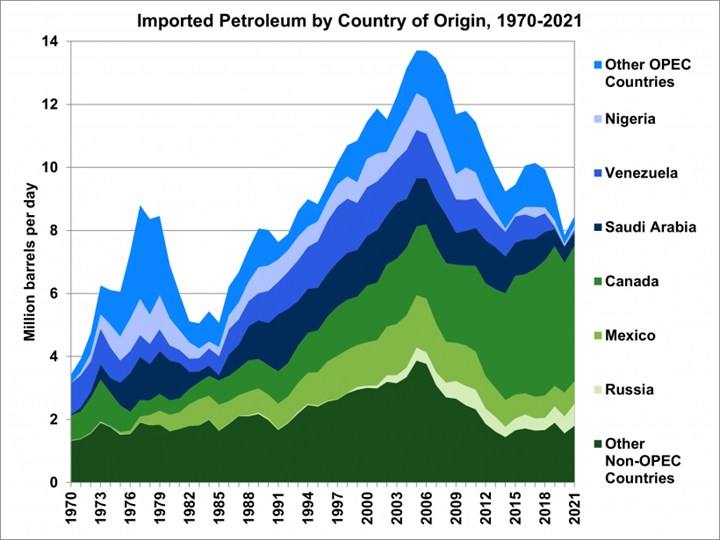
The amount of oil imported from Canada into the U.S. is clearly quite significant. (Image: U.S. Energy Information Administration)
Last week President Joe Biden announced that oil from the Strategic Petroleum Reserve (SPR), the world’s largest emergency reserve—with an authorized storage capacity of 714 million barrels—would be deployed as the effect of the war in Ukraine has caused conditions that meet the conditions of the Energy Policy and Conservation Act (which was signed into law in 1975 by Gerald R. Ford).
The oil is stored in 60 underground salt caverns at four locations: two each in Texas and Louisiana, along the Gulf Coast. Each cavern is cylindrical, with a diameter of about 200 feet and a height of 2,550 feet.
Last year the U.S. imported oil from a number of countries.
The number-one source, representing 50.8% of all U.S. petroleum imports in 2021 was. . .Canada.
Yes, our neighbor to the north. (Unless you live in Detroit and can say “our neighbor to the south”: Windsor is south of Detroit.)
According to the U.S. Energy Information, no other single country supplied oil in double-digit percentages.
The other major sources:
- Mexico: 8.5%
- Russia: 8.3%
- Saudi Arabia: 5%
Eleven percent came from the Organization for Petroleum Exporting Countries (OPEC): Algeria, Angola, Iran, Iraq, Kuwait, Libya, Nigeria, Qatar, Saudi Arabia, United Arab Emirates, and Venezuela.
///
A Clever Approach to Developing Autonomous Tech
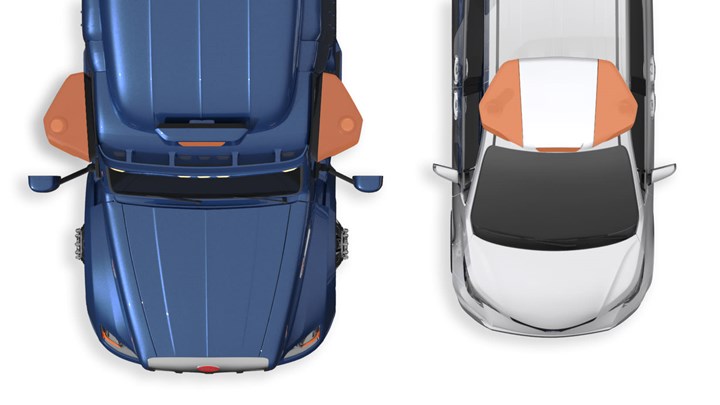
Whether on a big rig or a minivan, Aurora is developing its AV sensors for deployment across vehicle types. (Image: Aurora)
Aurora, which is developing autonomous hardware and software for vehicles (e.g., it has even developed its own lidar), announced in late March that its tech is being deployed in a test fleet of Toyota Sienna minivans in the Dallas-Fort Worth Area.
(An initial run brought some Toyota execs along part of the route between Toyota North America HQ in Plano and DFW. Arguably, airport runs are going to be a big part of any ride-hailing service’s daily drive.)
Aurora refers to its system as the “Aurora Driver.” It includes the self-driving software, hardware (cameras, lidar, radar, processors, etc.) and maps, offboard support, and other data services.
Virtual Soccer Moms & Truckers
Within a couple weeks after that announcement the company said that Aurora Driver Beta 2.0, the system being used in the Siennas, is being deployed on Peterbilt 579 trucks making autonomous commercial runs (with a safety driver on board) between Fort Worth and El Paso. About 600 miles.
This release allows the vehicles to do things like deal with construction zones—from negotiating concreate barriers to adjusting to temporary speed limits and lane closures—which are increasingly characteristic as infrastructure rebuilding is increasing.
Common Core
But here’s something notable about its approach to development: Aurora is creating what it calls a “Common Core of Technology.”
It is building pods that contain the necessary hardware and software systems that can be readily deployed to Peterbilts and Siennas alike. (After all, they are on the same roads with the same challenges.)
This approach provides scale. And scale can help drive down costs for the Aurora Driver.
The company is developing two products:
- Aurora Horizon for trucking
- Aurora Connect for ride-hailing
By basing them on common technology, there are greater benefits for both (i.e., the operational learnings from one can be leveraged by the other).
An interesting way to leverage development, production and deployment resources.
///
Making It for the Middle Class
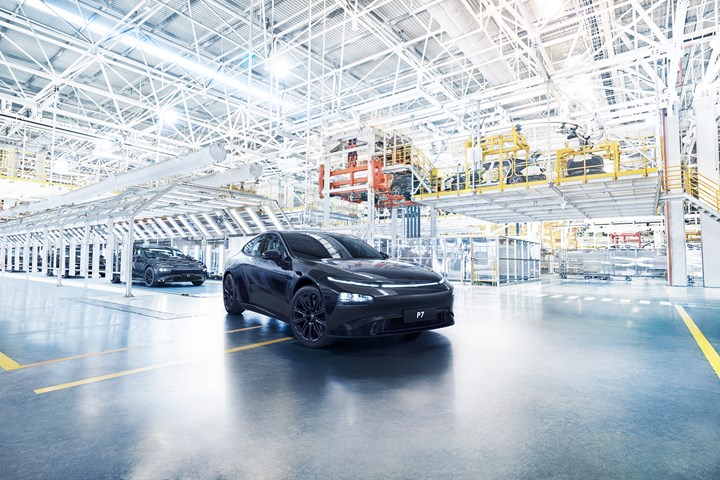
The 100,000th XPeng P7 off the line at the company’s Zhaoqing plant. (Image: XPeng)
This is something to keep in the back of your mind when you think about the global growth of electric vehicles, especially in the context of new competitors:
XPeng, a Guangzhou, China-HQ’d company that describes itself as one that “designs, develops, manufactures, and markets Smart EVs that appeal to the large and growing base of technology-savvy middle-class consumers in China,” announced a couple weeks back that it had produced 100,000 P7 sedans, which, it claims, is “the first model from a Chinese pure-EV brand to reach the production milestone of 100,000 units.”
It took 695 days to make that many.
Last week it announced its Q1 deliveries: 34,561 vehicles. There are four models in its lineup, two sedans and two SUVs.
That 34,561 is a 159% year-over-year increase. Sure, that’s not a big number for four vehicles over three months, but pay attention to the growth.
The Chinese Middle Class
A Brookings Institute report, “China’s Influence on the Global Middle Class,” states, “By 2027, we estimate that 1.2 billion Chinese will be in the middle class, making up one quarter of the world total.”
That demographic needs to be considered in the context of XPeng’s market focus.
Not all 1.2-billion are going to be buying XPeng’s, but it certainly is clever of the company to be focused on that segment:
When is the last time you heard of a company based in the U.S. or Europe stating that they’re making vehicles for the middle class?
Aren’t all of them trying to position themselves as being “aspirational”?
Big Spend. Big Impact.
The Brookings’ researchers point out that in 2020 middle class expenditures in China were $7.3-trillion. . .compared with the U.S., in second place, at $4.7-trillion.
The authors describe China as “a priority market for major multinational firms.”
Arguably, the Chinese middle class consumers are going to have a huge impact on what middle class consumers in the rest of the world will buy.
Which is why companies like XPeng are worth paying attention to.
///
Quote Without Comment
“Electric vehicles powered by low-GHG [greenhouse gas] emissions electricity have large potential to reduce land-based transport GHG emissions, on a life cycle basis (high confidence). Costs of electrified vehicles, including automobiles, two and three wheelers, and buses are decreasing and their adoption is accelerating, but they require continued investments in supporting infrastructure to increase scale of deployment (high confidence). Advances in battery technologies could facilitate the electrification of heavy-duty trucks and complement conventional electric rail systems (medium confidence).”—Climate Change 2022: Mitigation of Climate Change, Working Group III contribution to the Intergovernmental Panel on Climate Change Sixth Assessment Report
RELATED CONTENT
-
On Electric Pickups, Flying Taxis, and Auto Industry Transformation
Ford goes for vertical integration, DENSO and Honeywell take to the skies, how suppliers feel about their customers, how vehicle customers feel about shopping, and insights from a software exec
-
on lots of electric trucks. . .Grand Highlander. . .atomically analyzing additive. . .geometric designs. . .Dodge Hornet. . .
EVs slowdown. . .Ram’s latest in electricity. . .the Grand Highlander is. . .additive at the atomic level. . .advanced—and retro—designs. . .the Dodge Hornet. . .Rimac in reverse. . .
-
Jeeps Modified for Moab
On Easter morning in Moab, Utah, when the population of that exceedingly-hard-to-get-to town in one of the most beautiful settings on Earth has more than doubled, some people won’t be hunting for Easter eggs, but will be trying to get a good look at one of the vehicles six that Jeep has prepared for real-life, fast-feedback from the assembled at the annual Easter Jeep Safari.


.jpg;width=70;height=70;mode=crop)






